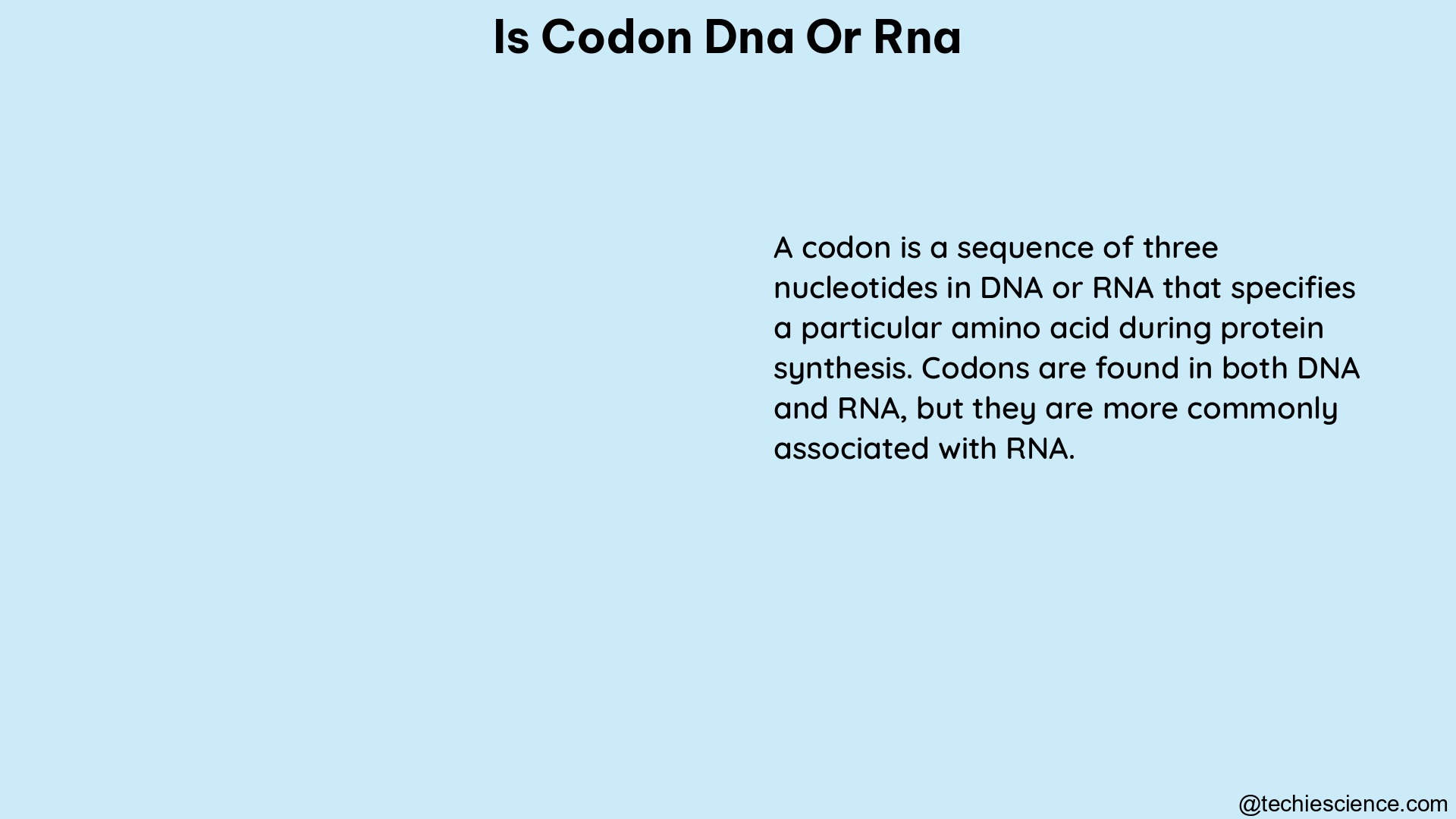Codons are the fundamental units of the genetic code, responsible for translating the information stored in DNA or RNA into the amino acid sequence of proteins. Understanding the nature of codons, whether they are composed of DNA or RNA nucleotides, is crucial for comprehending the central dogma of molecular biology and the mechanisms of protein synthesis.
The Composition of Codons
Codons are sequences of three consecutive nucleotides that specify a particular amino acid during the process of translation. These nucleotides can be derived from either DNA or RNA, depending on the stage of the gene expression process.
Codons in DNA
In the DNA molecule, the four possible nucleotides are adenine (A), thymine (T), cytosine (C), and guanine (G). These nucleotides are arranged in a specific sequence to form the genetic code, with each codon consisting of three consecutive DNA nucleotides.
For example, the codon “ATG” in DNA represents the amino acid methionine, which is often the starting amino acid in protein sequences.
Codons in RNA
During the process of transcription, the genetic information stored in DNA is copied into a complementary molecule called messenger RNA (mRNA). In RNA, the four possible nucleotides are adenine (A), cytosine (C), guanine (G), and uracil (U), which replaces thymine (T) found in DNA.
Consequently, the codons in RNA are also composed of three consecutive RNA nucleotides, such as “AUG” for methionine.
The Genetic Code and Codon Assignments

The genetic code is a set of rules that governs the translation of the genetic information from DNA or RNA into the amino acid sequence of proteins. This code is universal, meaning it is shared by all known living organisms, from bacteria to humans.
The Codon Table
The genetic code can be represented in a codon table, which shows the correspondence between the 64 possible codons (combinations of three nucleotides) and the 20 standard amino acids used in protein synthesis.
| Codon | Amino Acid |
|---|---|
| AUG | Methionine |
| GUC | Valine |
| CUA | Leucine |
| … | … |
The codon table reveals that most amino acids are represented by multiple codons, a phenomenon known as codon redundancy or degeneracy. This redundancy allows for flexibility in the genetic code, as different codons can code for the same amino acid.
Codon Assignments and the Genetic Code
The specific assignments of codons to amino acids are determined by the base-pairing rules of nucleic acids. During translation, the mRNA codon is read by a transfer RNA (tRNA) molecule, which carries the corresponding amino acid. The tRNA recognizes the codon through complementary base-pairing, with the anticodon on the tRNA matching the codon on the mRNA.
For example, the codon “AUG” on the mRNA is recognized by a tRNA molecule with the anticodon “UAC,” which carries the amino acid methionine.
Codon Bias and Its Significance
Codon bias is a phenomenon where certain codons are used more frequently than others in the coding regions of genes. This bias is observed across different organisms and has been shown to have significant implications for gene expression and protein production.
Measuring Codon Bias
Two common measures of codon bias are:
- GC3-content: The sum of the codon frequencies of GC3 codons (codons with G or C in the third position) expressed as a percentage.
- Codon Adaptation Index (CAI): A quantitative measure that evaluates how well a given codon matches the biases of an organism, ranging from 0 to 1. A CAI of 1 indicates that all amino acids are translated from the most frequently used codons in that organism.
Implications of Codon Bias
Codon bias has been shown to have several important implications:
- RNA Stability: Codon bias, as measured by GC3-content, is strongly correlated with RNA stability in humans. Codons with higher GC3-content tend to be more stable and less prone to degradation.
- Protein Production: The Codon Adaptation Index (CAI) is a reliable predictor of protein expression levels. Genes with higher CAI values tend to have higher protein production rates.
- Evolutionary Adaptation: Codon bias can be influenced by factors such as tRNA abundance, translational efficiency, and mutational biases, and it can reflect the evolutionary adaptation of an organism to its environment.
Conclusion
In summary, codons are the fundamental units of the genetic code, responsible for translating the information stored in DNA or RNA into the amino acid sequence of proteins. Codons can be composed of either DNA or RNA nucleotides, depending on the stage of the gene expression process. Understanding the nature of codons and the genetic code, as well as the phenomenon of codon bias, is crucial for comprehending the mechanisms of protein synthesis and gene expression in living organisms.
References
- Codon bias confers stability to human mRNAs – PMC – NCBI
- Translation: DNA to mRNA to Protein | Learn Science at Scitable
- Codon Table | VectorBuilder
- Biology chapter 13 Flashcards | Quizlet
- Chapter 15 Flashcards – Quizlet

Hi, I am Milanckona Das and pursuing my M. Tech in Biotechnology from Heritage Institute of Technology. I have a unique passion for the research field. I am working in Lambdageeks as a subject matter expert in biotechnology.
LinkedIn profile link-